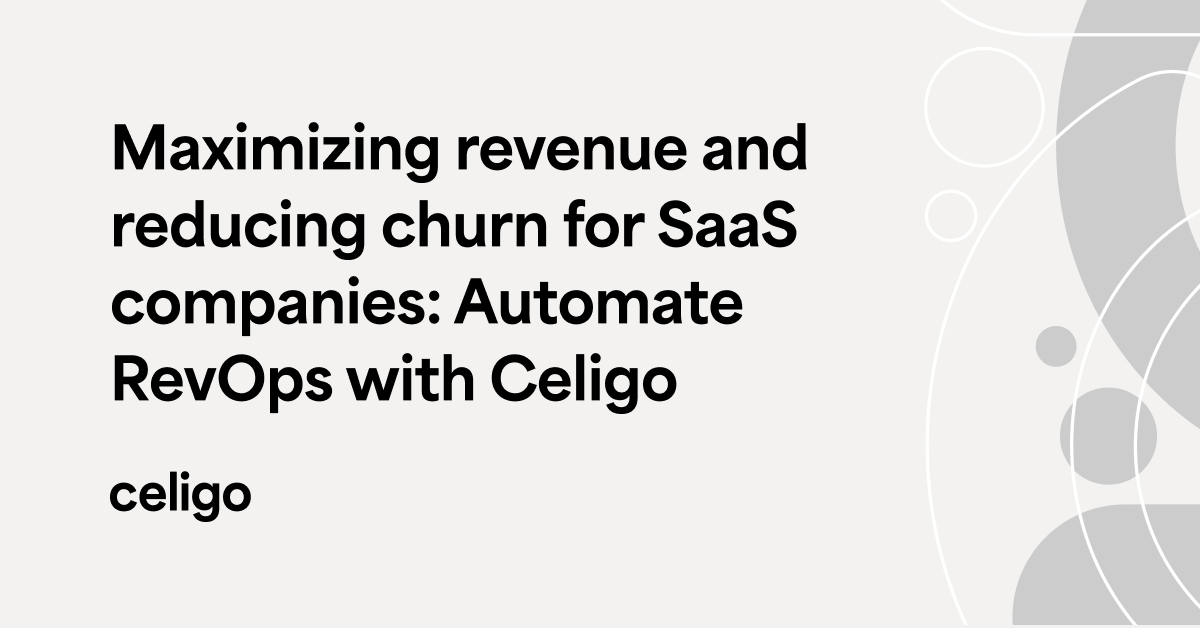Published Oct 16, 2024
Maximize revenue, minimize churn with the power of automation

- Manual revenue operations result in errors, slower follow ups, and funnel leaks.
- Automate processes like lead lifecycle management and quote-to-cash to ensure consistency.
- Utilize an iPaaS to enhance and simplify the automation process.
Running a successful SaaS company requires more than just a great product, especially in times of economic uncertainty. To stay competitive, reduce churn, and increase revenue, you must deliver excellent customer experiences. This starts with streamlined revenue operations.
Revenue operations encompass marketing, sales, and service operations. These functions help you drive consistency and predictability in your revenue pipeline.
Unfortunately, these operations are often filled with manual processes–resulting in errors, delays, and frustrated customers. To address these challenges and ensure success, you need automation.
Discover how automating processes like quote-to-cash, product usage, and lead lifecycle management can help facilitate collaboration among marketing, sales, and customer success teams, minimize churn, and drive sustainable growth. Check out our on-demand webinar, “Maximizing revenue and reducing churn for SaaS companies: Automate RevOps with Celigo,” for expert advice on how to get started.
Here’s a look at what we discussed.
The true cost of manual processes
Manual processes are not only time-consuming, but they also result in slower follow-ups, funnel leaks, and the risk of falling behind competitors who can move faster. This has a big impact on your bottom line. In fact, taking longer than 5 minutes to respond to leads, reduces conversion rates by 8 times. Manual processes make following up quickly impossible, as marketing teams must manually transfer lead information into your sales systems.
Manual data entry tasks are susceptible to errors, which can cause valuable leads to slip through the cracks. These processes also rely on marketing teams to notify sales when new leads are ready for action. Without effective communication, even more leads can get missed. Consequently, 77% leads are not responded to at all.
On top of that, when your team spends time on repetitive tasks, they have less time to focus on strategic initiatives that drive growth. Sales reps spend just 28% of their week actually selling. Imagine what your team could do if you doubled that.
For existing customers, manual processes can prevent you from recognizing poor adoption until it’s too late. This increases your churn rates.
All of these inefficiencies ultimately result in lost revenue.
Automating revenue operations
The good news is you don’t have to rely on manual processes. By automating key tasks throughout your revenue operations, you can ensure flawless experiences at every stage of the customer journey.
Explore the impact automation has on these three processes:
Lead lifecycle management
Effective lead lifecycle management is crucial for converting prospects into customers. This process often involves tracking and nurturing leads through various stages of the buyer’s journey. By automating lead capture, enrichment, and engagement, you can ensure that high-priority leads are automatically routed to the right sales reps, ensuring follow up and increasing the chances of conversion.
To make these automations possible, integrate your data enrichment tools, customer relationship management (CRM) system, and marketing automation platform (MAP). These integrations allow you to sync data between systems–eliminating the need for manual data entry tasks.
Explore three key lead lifecycle automation use cases.
Quote-to-cash
The quote-to-cash process covers the entire sales cycle—from generating a quote to receiving payment. Automating this process improves accuracy and efficiency, reducing the time it takes to go from a prospect to a paying customer.
Start by integrating your core systems, such as your CRM and enterprise resource planning (ERP) system. With data syncing between these systems, you can automate key tasks like creating quotes, order processing, billing, and more.
Learn how you can sync key data between your CRM and ERP.
Product usage
The process of tracking, analyzing, and acting on product usage data is key to improving customer experiences. With automation, your teams can quickly identify customers who haven’t hit usage milestones–allowing them to take proactive actions to prevent churn. This process can also be used to identify upsell opportunities.
Connect your storage and analytics databases with your CRM and messaging tools to enable automations like alerts when product usage dips. With this holistic data flowing between systems, you can also gain key insights into customer behaviors.
Discover how automation can help you better track product usage.
Aligning your GTM team
Marketing, sales, and customer success are all critical to your ability to ensure positive customer experiences. However, this is only possible when your teams are aligned and working together.
Integration and automation help ensure your teams are on the same page. Here’s how:
- Marketing and sales alignment: When marketing data is siloed, sales teams lack key insights into lead interactions. With data flowing between your MAP and CRM, your teams can access the same lead information across systems.
- Sales and customer success collaboration: Aligning your sales and customer success teams is vital for driving product adoption and capitalizing on upsell opportunities. By syncing data between your CRM and data storage systems, you can provide both teams with the key product usage insights they need to work together effectively.
- Data-driven decision making: Integrating data from marketing, sales, and customer success teams allows for a holistic view of the customer journey. This integrated approach enables better decision-making, and helps you to identify opportunities for upselling, cross-selling, and improving customer retention.
Boosting revenue with Celigo
Maximizing revenue and reducing churn are essential for the success of any SaaS business. By automating your revenue operations and aligning your teams, you can streamline workflows, improve customer experiences, and drive growth.
With Celigo’s advanced iPaaS, you can make integration and automation even easier for your team. Celigo’s low-code environment, intuitive interface, and AI error management capabilities enable non-technical users to build their own integrations. This means your marketing, sales, and customer success teams can automate the processes they know best.
Take the first step towards transforming your SaaS business, watch the full webinar today.




